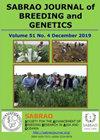RESISTANCE OF DOUBLED HAPLOID RICE LINES TO BACTERIAL LEAF BLIGHT (Xanthomonas oryzae pv. oryzae)
IF 1.7
Q3 PLANT SCIENCES
引用次数: 0
Abstract
Developing new high-yielding rice varieties resistant to bacterial leaf blight (BLB) is an effective strategy for controlling BLB. Several advanced doubled haploid rice lines derived from anther culture previously selected need assessment for BLB resistance. This study aimed to evaluate the resistance of these lines to BLB pathotypes III, IV, and VIII in the vegetative and generative phases. The experiment took place in a greenhouse using 16 rice genotypes comprising 12 doubled haploid rice lines, two commercial check varieties (Inpari 18 and Inpari 34), and a BLB-resistant and susceptible check variety (Code and TN-1, respectively). Inoculation began with the leaf clipping method using a suspension of the pathogen Xanthomonas oryzae pv. oryzae (Xoo) at a concentration of 109 cfu/ml. The results indicated significant influences on disease severity and intensity of BLB of pathotype, genotype, and the interactions between pathotype and genotype, finding their values higher in the vegetative phase. Six doubled haploid lines ranged from resistant to moderately resistant (disease severity 2.0%–10.7%, disease intensity 6.7%–36.8%) to pathotypes III and IV in two growth phases, i.e., HS1-35-1-4, HS4-15-1-9, HS4-15-1-16, HS4-15-1-24, HS4-15-1-26, and HS4-15-1-28. All those doubled haploid lines were susceptible to BLB pathotype VIII in the vegetative phase and moderately susceptible in the generative phase.水稻双单倍体品系对水稻白叶枯病的抗性研究。oryzae)
培育抗白叶枯病高产水稻品种是防治白叶枯病的有效策略。先前选择的几个由花药培养获得的高级双单倍体水稻品系需要对BLB抗性进行评估。本研究旨在评估这些品系在营养和生殖阶段对BLB III、IV和VIII病型的抗性。试验在温室中进行,使用16种水稻基因型,包括12个双单倍体水稻品系、2个商业对照品种(Inpari 18和Inpari 34)和1个抗blb和敏感对照品种(Code和TN-1)。接种开始与叶片剪法使用病原体米黄单胞菌pv悬浮液。oryzae (Xoo)浓度为109 cfu/ml。结果表明,致病型、基因型及致病型与基因型的相互作用对BLB的发病严重程度和强度有显著影响,且在营养期影响较大。6个双单倍体株系在HS1-35-1-4、HS4-15-1-9、HS4-15-1-16、HS4-15-1-24、HS4-15-1-26、HS4-15-1-28两个生长期对III型和IV型的抗病至中抗性(病重2.0% ~ 10.7%,病强6.7% ~ 36.8%)不等。所有双单倍体系在营养期对BLB VIII型易感,在生殖期中等易感。
本文章由计算机程序翻译,如有差异,请以英文原文为准。
求助全文
约1分钟内获得全文
求助全文
来源期刊

Sabrao Journal of Breeding and Genetics
农林科学-奶制品与动物科学
CiteScore
1.90
自引率
50.00%
发文量
63
期刊介绍:
The SABRAO Journal of Breeding and Genetics is an international journal of plant breeding and genetics research and was first published in 1969. It is the official publication of the Society for the Advancement of Breeding Research in Asia and Oceania (SABRAO).
Its objectives are to: promote the international exchange of research information on plant breeding and genetics, by describing new research findings, or ideas of a basic or practical nature; and be a medium for the exchange of ideas and news regarding members of the Society.
The Journal gives priority to articles that are of direct relevance to plant breeders and with emphasis on the Asian region. Invited for publication are research articles, short communications, methods, reviews, commentaries, and opinion articles. Scientific contributions are refereed and edited to international standards.
The journal publishes articles for SABRAO members mainly. The Journal preferred strongly that at least one author should be a current member of the Society. Non-members may also publish in the journal.
 求助内容:
求助内容: 应助结果提醒方式:
应助结果提醒方式:


